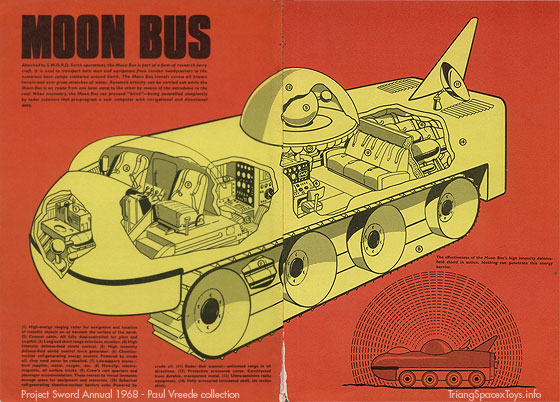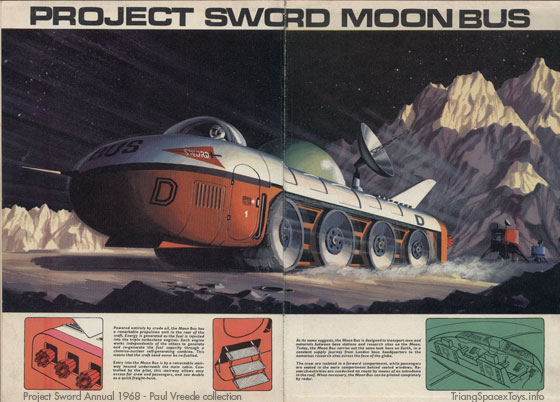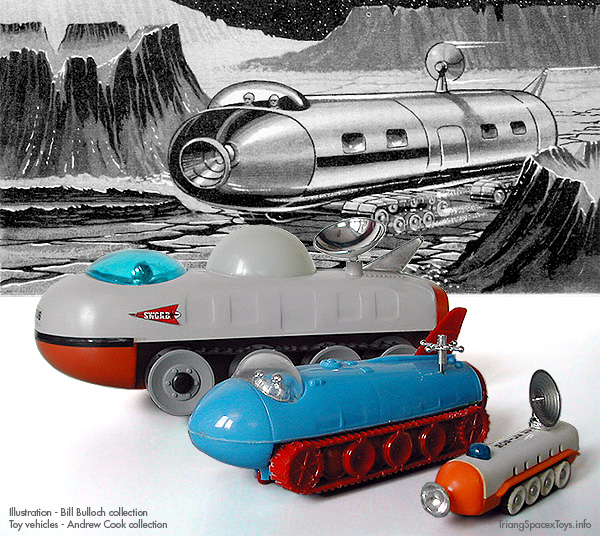
The exact shape of the Spacex Mobile HQ family tree isn't clear at present; but its components are shown above: the earliest known illustration of this type of vehicle, and its parents or possibly parent and cousin: the Project Sword Moon Bus and the Moon-Explorer Car. However they may turn out to be related, the family resemblance is plainly visible. But as the picture above clearly shows, the designers of the Spacex HQ will have seen the illustration. Although the Mobile HQ shares its colour scheme and chassis design with the Sword Moon Bus, the nose cone with scanning dish is plainly copied from the book illustration.
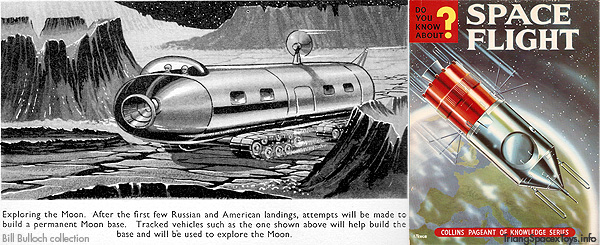
The illustration is by I. Teece, which Bill Bulloch found in the Space Flight book from the Collins Pageant of Knowledge series published in the UK in 1962. It's an illustration that stands on its own with a caption - the other text in the book doesn't mention this vehicle at all. Design-wise I believe the vehicle most likely is pure speculation by Mr Teece.
Comic Strip Cameo
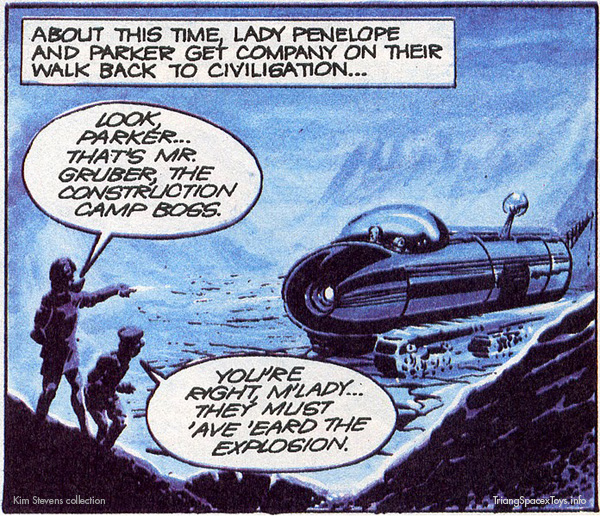
Mr Teece's illustration must also have been seen by artist Frank Langford, who used a remarkably similar vehicle in one panel of a Lady Penelope comic strip in issue nr 42 of the eponymous magazine, published 5 November 1966.
Moon-Explorer Car
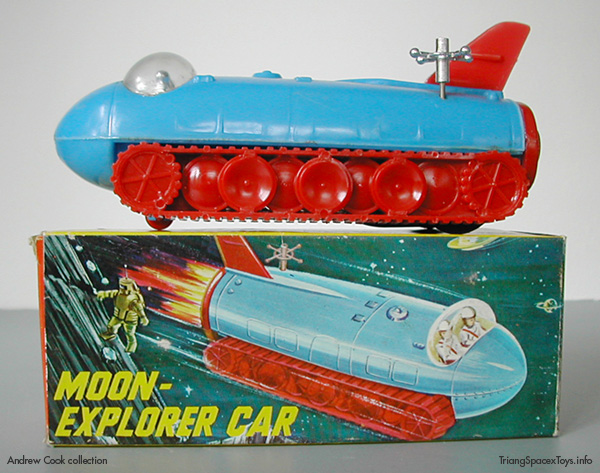
The Moon-Explorer Car is part of a series of larger space toys produced by LP of Hong Kong. Whether it predates the Project Sword Moon Bus (see below) is uncertain, although the suit on the astronaut floating in space in the box art would suggest this was painted before LP became familiar with the Mercury astronauts' spacesuits.
The vehicle itself is 140 mm or 5.5" long and has a friction motor which drives two hidden wheels and also makes the antenna spin. It also exists in alternative versions shown on its own page (Use your browser's Back button to return here).
Although different in various details, the overall design of this toy is clearly based on Teece's illustration. Especially the identical placement of side windows and doors is a dead give-away here. LP appears to have introduced the rocket propulsion for this vehicle (thus giving their illustrator the idea the thing would fly), which I find completely at odds with those unwieldy caterpillar tracks (especially if used in take-off or landing). On the plus side, they did do a better job of integrating the chassis with the body shell, and also saw fit to replace Mr Teece's rather haphazard track arrangement with a suspension system that had proven to be both reliable and robust.
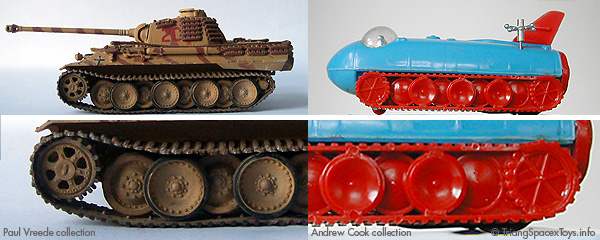
Project Sword Moon Bus
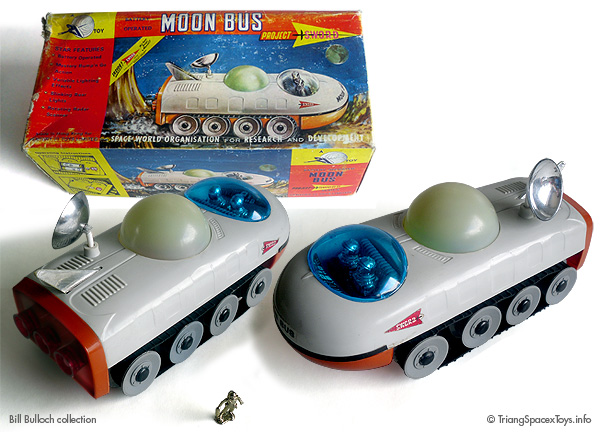
The Project Sword Moon Bus marketed by Century 21 Toys (and subsequently also produced for Tarheel in the US) is an impressive vehicle measuring 238 mm or 9 3/8" in length. It's battery-operated; featuring mystery bump'n'go action (a rotating drive system under the nose that makes the vehicle turn away from walls and furniture before resuming its way forward). The motor also rotates the radar dish while lights sparkle under the central dome and blink behind the triple exhaust, while the vehicle's progress along the floor turns the wheels and thus the tracks.
The Moon Bus was manufactured in Hong Kong by Tai Hing (a company still in business today), who initially produced it with their T-in-a-circle trademark incorporated in the vehicle's nose as is even shown in early Project Sword photographs. It's one of the few Project Sword vehicles marked with a registered design number, which allowed Paul Woods to identify its manufacturer when he obtained a copy of the registration documents from the British National Archives.
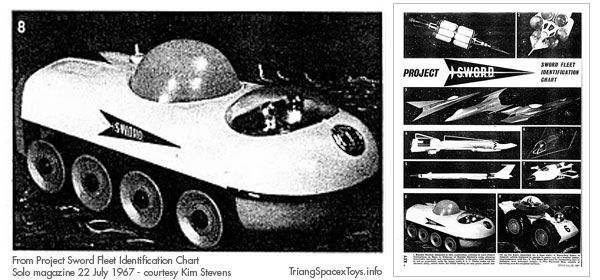
Project Sword advert showing the original Moon Bus with Tai Hing logo on its nose.
As part of the Project Sword fleet, the Moon Bus received two spreads in the Project Sword Annual, hoping this might attract readers to buy the toy (click on images for larger view in new window). The technical drawing is by Eric Eden, the painter of the second illustration remains unknown.
